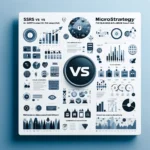In the ever-evolving landscape of cloud-based data services, Microsoft offers two powerful tools – Azure Synapse Analytics and Azure Data Factory. These tools serve distinct purposes but are often used in conjunction for comprehensive data management and analytics. In this blog post, we’ll delve into the key differences between Microsoft Synapse and Data Factory, shedding light on their features, use cases, and how they complement each other in the world of data processing and analytics.
Table of Contents
ToggleMicrosoft Synapse Analytics: A Comprehensive Overview
Azure Synapse Analytics, formerly known as SQL Data Warehouse, is a cloud-based analytics service that brings together big data and data warehousing into one unified platform. It allows users to analyze large volumes of data in real-time, providing insights into business analytics and facilitating streamlined data exploration.
Azure Data Factory: Understanding the Basics
Azure Data Factory is a cloud-based data integration service that allows users to create data-driven workflows for orchestrating and automating data movement and data transformation. It enables seamless data extraction, transformation, and loading (ETL) processes, supporting a variety of data stores both on-premises and in the cloud.
https://synapsefabric.com/2023/12/21/what-is-the-difference-between-azure-data-factory-and-synapse-studio/
Key Differences between Microsoft Synapse and Data Factory
1. Purpose and Use Cases:
- Synapse Analytics: Primarily designed for analytical processing and business intelligence. It combines big data and data warehousing for real-time analytics.
- Data Factory: Focused on data integration and orchestration. It is used for creating ETL workflows to move and transform data between various sources and destinations.
2. Data Processing Paradigm:
- Synapse Analytics: Supports both on-demand and provisioned resources for data processing, enabling users to scale resources based on workload requirements.
- Data Factory: Utilizes a serverless data processing model, where users pay only for the resources consumed during the execution of data workflows.
3. Data Transformation Capabilities:
- Synapse Analytics: Provides extensive data transformation capabilities with built-in T-SQL, allowing users to perform complex transformations directly within the platform.
- Data Factory: Offers a wide range of data transformation activities and allows users to use Azure Data Flow for more complex transformations.
4. Integration with Other Azure Services:
- Synapse Analytics: Seamlessly integrates with various Azure services like Azure Machine Learning, Power BI, and Azure Databricks for advanced analytics and reporting.
- Data Factory: Integrates with a variety of Azure services and data stores, allowing users to create end-to-end data workflows across the Azure ecosystem.
https://synapsefabric.com/2023/12/15/unlocking-cloud-potential-azure-sql-database-vs-azure-synapse-analytics/
External Resources:
Enhance your understanding of Microsoft Synapse and Data Factory with these external resources:
Frequently Asked Questions (FAQs):
Q1: Can I use both Synapse Analytics and Data Factory together?
A1: Yes, many organizations use both services together. Data Factory can be used to move and transform data, feeding it into Synapse Analytics for advanced analytics and reporting.
Q2: How does pricing differ between Synapse Analytics and Data Factory?
A2: Both services have separate pricing models. Synapse Analytics pricing is based on provisioned resources, while Data Factory pricing is based on the resources consumed during data workflows.
Q3: Does Data Factory support real-time data processing?
A3: While Data Factory is more focused on batch processing, it does support near real-time data processing using activities like tumbling window triggers.
Q4: What programming languages are supported in Synapse Analytics and Data Factory?
A4: Synapse Analytics supports T-SQL, and Data Factory supports JSON-based expressions for defining data workflows.
Q5: Can I use Synapse Analytics or Data Factory for data warehousing?
A5: Synapse Analytics is specifically designed for data warehousing, while Data Factory is used for orchestrating data workflows, including data movement into data warehouses.
Q6: Are there any limitations on the volume of data that Synapse Analytics and Data Factory can handle?
A6: Both services are designed to handle large volumes of data. The capacity and performance can be scaled based on the specific requirements of your workload.
Conclusion:
In conclusion, Microsoft Synapse Analytics and Data Factory cater to different aspects of the data management and analytics lifecycle. Synapse Analytics focuses on providing a unified analytics platform with powerful processing capabilities, while Data Factory specializes in orchestrating seamless data workflows. Understanding the distinctions between these services allows organizations to leverage the strengths of each tool effectively, creating a comprehensive and efficient data processing ecosystem in the Azure cloud.






